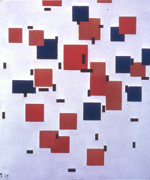You are in: Home page > Magazine Archive > The Banco de Bilbao by Francisco J. Sáenz de Oíza

Carlo Gandolfi
The Banco de Bilbao by Francisco J. Sáenz de Oíza
“Like an industrial nave”

Banco de Bilbao, Francisco Javier Sáenz de Oíza
Abstract
A kind of white sheet with isolated colored regions in a grid, white as the background, like the undivided space is the first idea that Francisco Saenz de Oiza fixed for the conception of the Banco Bilbao headquarters designed in Madrid in 1974: the spatiality characterizes the floors of the tower revealing, at the outside, the neatness and the clarity of a pure and indelible form, which does not appear to be assertive or self-referential. An urban object that does not split the technical and engineering aspects, from the structural and expressive. An architectural reasoning that, forty years after the project is, in the city of Madrid and in general, an exemplary construction about thinking modernity at the scale of the city and the building’s user, which teaches us to think the project as an opportunity of profound reflection and learning.
One of the presuppositions of the project entry for the public tender won by Sàenz de Oíza for the Banco de Bilbao office tower was to elevate the foundation structures starting from a subsoil level since it was necessary to build above the railway tunnel de la Risa whose construction began back in the ‘30s, and that crosses under the Paseo de la Castellana. A heavy restriction that would end up being the motor behind the building’s structural ingenuity.
“I was inspired by a sketch of Mondrian in creating the Banco de Bilbao; this sketch was at hand on many occasions. The white plane can be seen, but the format of the paper has not been reduced, the white lies beneath”2: a white sheet, with areas of colour isolated in a grid, the white as a background, just like the undivided space that characterizes the standard floors of the Madrid tower.
An extraordinary pair of sketches made in the United States in 1946 renders the idea of how much Oíza found it impossible to ignore the technical installations as a signed and sealed fact, and how this was the departure point to harmonize the spaces between the networks and infrastructure. A similar attitude has the merit of making the building’s shape (and space) consistent with the structural apparatus: the idea of a contextual building inseparable from its skeleton and its organs.
We need to linger over some passages in the project report: “Our proposal is split into two different levels. A macro-structure resistant to the heavy actions of gravity or dynamic loads and a structure of spatial subdivision […]. Every five floors, the structure proposed offers a totally diaphanous plan devoid of pillars right across its 30x40 metre surface, presupposing that 20% of the offices’ total scheme will constitute a single working environment. These large, diaphanous working environments lie in the spaces immediately below the great suspended structure in reinforced concrete, so that the internal volume of these work areas increases across the space between the slabs (of the single structural nuclei, author’s note). The visible constructional epopea of this structure, will end up sufficiently clear at an urban level, since it can be perceived historically, as an indelible shape.”3
From this description manifests the relationship between spatial conception and structural idea, systematized in the drawings of the plans and the building’s standard section.
In fact, this is a sort of reversal: the idea of superimposing floors is overturned in favour of a hanging mechanism of nuclei; an intelligent, innovative use of the force of gravity. The question immediately arises as to why this sort of conceptual shift would occur: there can be many answers; certainly the most interesting from an architect’s point of view lies in Oíza’s design approach. Throughout the Spanish architect’s work a sort of methodological datum recurs, which is translated into many results: the non-conventional. Each project is a case in its own right; there are no linguistic figures or preconceived forms. Each project is a reflection, a re-beginning, a new invention which, starting from different themes and places, represents a step forward, progress in his research4, in the name of “every aspect of that American spirit of invention”5 which was to guide him through a profession lasting half a century.
Another interesting fact is his relationship with the city of Madrid, its urban role. A declaration of monumentality in his cherished indelibility right from the start, but without necessarily ignoring a painstaking search for relationships with the outside. The façade is a genuine technical and linguistic device: The dialectic between exterior and interior cannot be resolved in some absurd dialectic that rigidly divides inside and outside by means of an elementary diaphragm of glass […]. The definition of the threshold concept, an area restricting interpenetration and projection […]. Also included is a second system of metal sunscreens that definitively define this condition of threshold, or ring of interrogation on inside-outside. […] Traditional corners obey a technology bound to brick and stone that deserves to be reconsidered. The exterior penetrates the interior through this façade-sponge of sensitive skin.”6
It is as if the tower features in a totally neutral manner with respect to the city of Madrid; as if it looked at the city without a direction, as if it wanted to have always been there, in a form that is simultaneously archetypical and prototypical: a buildings that “presents itself as a summary of different attitudes; a summary sweetened like the rounded-off corners of a rectangle, (…) the open plan, the office-landscape, surrounded by a terse façade of a subtle expessionism.”7
The problem of urban towers’ and skyscrapers’ “neutrality” is, in fact, ingrained in the very notion of a tower, in the semantic origins of its square ground plan, which annuls the concept of a main façade for the sake of three hundred and sixty degree visibility. Its strong technical component – which poses an unequivocal cross reference to its objective character – intimates a tower that could sit anywhere, in any city, for any bank. However, this is merely superficial. It is simply not true that we could move many towers or skyscrapers from one city to another in a sort of globalizing, pointsman process of a passe-partout type. In fact, we have seen how its structure starts from a restriction that is secreted in the city’s bowels and how, starting off from this restriction, the designer managed to show how a project’s validity lies also in its capacity to resolve a problem by invoking an even greater one. The solution and the structural whole, its bulk, were born out of what already existed. Virtually a sort of symbiotic afflatus arising from the city itself, albeit not a physical connection between the tunnel and the tower, but a condition of tangency and coexistence.
The relationship with the city finds a further exchange point – the great hall on the ground floor. To better grasp this relationship, let us resort to a comparison with the Seagram Buiding by Mies van der Rohe. On the one hand, the action of generating public space – a place of shelter, welcome and access – and, in fact, lifting the entire surrounding volume in the same manner as a stilt house or a portico surrounding a hard core and, on the other, that of sitting back from the roadway to form a space for stopping, pausing, and silence, delegating to that sort of transparent, light-filled basement the role of an exterior hall or urban anti-chamber.
This building, in addition to teaching us how the confines of so-called Organic and Functionalist architecture can easily be surpassed for the sake of unity in an architectural project, undoubtedly represents one of the most successful examples of how an edifice can bring together, with great consistency, construction daring and consummate passion without falling back on banal, shaky focuses on technique: “A structure of structures as proposed by the Archigram and Japanese Metabolists for the growth of a city of the future.”8
This project forces us to reason over how much a work of architecture can represent the coherent outcome of a particular line of reasoning, a summation of principles, a thought and a process that is – in the first instance – cultural. In short, how architecture is a cultural gesture and that its “being a technical art” means giving shape to cohesive, imagined ideas. Apart from anything else, how can architecture stand the test of time and announce its contemporary style in terms of construction techniques, language and form, through its look alone? One of the possible answers lies in the search for stability of form combined with efficacy in the built figure: “Oíza was a new Vitruvius who, despite having accepted to follow the most modest of roads (Oíza started his academic career as professor of Salubriedad y Igiene - Health and Hygiene), proved capable of showing how venustas is activated only when utilitas and firmitas have been satisfied.”9 The sense of completeness and unity repay the ambition to give Madrid a fundamental face among the thousands that design its cityscape. So fundamental as to become, not an icon, but an indelible landmark.
Notes
1 “Like an industrial nave, an office building is a complex work plan that is constantly adapting to its own precise constructive function.” from the tender memorandum, published in Banco de Bilbao: Sáenz de Oíza, Ed. Departamento de Proyectos Arquitectónicos de la ETSA, Madrid, 2000, pp. 33-34.
2 Rosario Alberdi, Javier Sáenz Guerra, Francisco Javier Sáenz de Oiza, Pronaos, Madrid, 1996, p. 148.
3 «El Croquis», n° 32-33, Francisco Javier Sàenz de Oíza 1947-1988, Madrid, 2002. p. 88. (Translation by the author; the italics are original)
4 Undoubtedly, this attitude may well hark back to Saenz’s years of training, his first travels in 1947-48 with a Conde de Cartagena Scholarship from the Real Academia de Bellas Artes de San Fernando: “ [...] I went to the United States to understand how people lived... Back from the States I got to know how traffic worked... the solution to one problem generates other problems.” Rosario Alberdi, Javier Sáenz Guerra, Francisco Javier Sáenz de Oíza, Pronaos, Madrid, 1996, p. 19.
5 Rosario Alberdi, Javier Sáenz Guerra, Op. cit., Pronaos, Madrid, 1996, p. 19.
6 «El Croquis», n° 32-33, Francisco Javier Sàenz de Oíza 1947-1988, Madrid, 2002. p. 90, 92.
7 José Manuel López-Pelàez, Oíza y el reflejo del Zeitgeist, in «El Croquis», op. cit., p. 199.
8 Javier Valles, OizaBB, in Banco de Bilbao: Sáenz de Oíza, Ed. Departamento de Proyectos Arquitectónicos de la ETSA, Madrid, 2000, pp. 15-19. In note 3 of this essay, Valles also recalls a piece by Alfonso Valdés La Conexión Americana, in «Arquitectura», n° 228, Jan. - Feb. 1981. In this essay, (in turn published in Banco de Bilbao: Sáenz de Oíza, pp. 27-31) Valdés acknowledges the relationships between the Banco de Bilbao project and those of the “megastructures” of Luis Kahn, Kenzo Tange, and the Japanese Metabolists.
9 Rafael Moneo, Perfil de Oíza joven, in «El Croquis», op. cit., p. 194.
Carlo Gandolfi. Architect (Politecnico di Milano), Phd in Architectural Composition at the IUAV of Venice, Researcher at the DICATeA - Department of Engineering and Architecture at the University of Parma, Italy.














